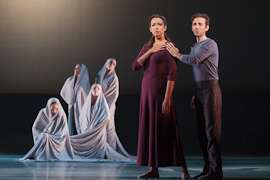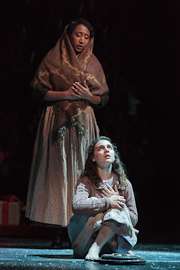|
Back
A creative pairing Albany
The Alice Busch Theater
07/20/2013 - & July 23, 25, 29*, August 3, 9, 18, 22, 2013
Giovanni Battista Pergolesi: Stabat Mater*
David Lang: when we were children – the little match girl passion
Anthony Roth Costanzo* (counter tenor), Nadine Sierra* (soprano), Lisa Williamson (soprano), Julia Minzer (mezzo-soprano), James Michael Porter (tenor), Christian Zaremba (bass)
Festival dance ensemble*, Jessica Lang* (choreographer and director), The Glimmerglass Festival Children’s Chorus, David Moody (conductor), The Glimmerglass Festival Orchestra*, Speranza Scapucci* (conductor)
Francesca Zambello (director), Andrea Beasom (choreographer), Marjorie Bradley Kellogg (set designer), Beth Goldenberg (costume designer), Mark McCullough (lighting designer)

N. Sierra, A. R. Costanzo (© Karli Cadel)
This double bill, titled “Passions”, consists of Pergolesi’s religious work, Stabat Mater (composed 1736), and David Lang’sthe little match girl passion (composed 2007) prefaced by his when we were children composed for this Glimmerglass production.
In recent decades there has been quite a trend toward staging religious works, notably those by Bach but also oratorios by Handel and Verdi’s Messa da Requiem. In this instance choreographer Jessica Lang deploys eight dancers with marvelous effectiveness. The dancers, who are also singers (but not in this production), are members of the Glimmerglass Young Artists Program (since Francesca Zambello has led the festival she has obviously made it a policy to engage double-threat singer/dancers. This is in keeping with casting the classic musicals but also results in greater ensemble animation as we see this season in Der fliegende Holländer and King for a Day.) The two singers, soprano Nadine Sierra and counter-tenor Anthony Roth Costanzo, also participate in the dancing.
Stabat Mater (“The Mother Stood”) is an expression of Mary’s grief at the crucifixion of her son. It does not recount any sort of story but in its 45-minute length takes us through a variety of sorrowful utterances – several stages of grief as it were (in fact a more complete title is Stabat Mater Dolorosa).
The singers handled their parts well although Nadine Sierra has a somewhat more outgoing, operatic approach than Mr. Costanzo.
The overall staging effect is a kind of restrained, limpid fervour, much in keeping with the music which is very nicely conducted by Speranza Scapucci. Marjorie Bradley Kellogg’s set with its use of large, weathered timbers enhances the proceedings extremely well, as do Beth Goldenberg’s costumes and Mark McCullough’s lighting.
The audience seemed spellbound by the performance and went mad with delight at the end.

L. Williamson, V. Munro (© Karli Cadel)
David Lang’s the little match girl passion (like the poets e.e.cummings and bp nichol he favours lower case titles) won the Pulitzer Prize in 2008. It requires a children’s chorus who not only sing but enact aspects of the story, plus four adult singers who are also called upon to play – very sparingly but with wonderful effect – a few percussion instruments. Aside from these few instruments, the piece is a capella (and conducted by the festival’s chorus master, David Moody). It is based, of course, on Hans Christian Andersen’s famous tale which is just a few paragraphs long (really more of a prose poem).
It was prefaced by when we were children for the 24-member chorus. The words are taken from multiple translations of the biblical passage in I Corinthians 13 that, in the King James version, are: “When I was a child, I spake as a child, I understood as a child , I thought as a child: but when I became a man, I put away childish things.” The piece does not work through the text in a linear way; individual words and short phrases are repeated in a tumbling-over-one-another fashion (apparently they are alphabetized). The effect is a kind of vocal collage. The children (children and youth, actually – some of the boys are baritonal) do a right professional job with it. One hopes they had fun learning it.
The Andersen tale is delivered fairly straightforwardly by the four solo singers (all members of the Young Artists Program) as each takes up a section of the story. They sing it in a form of plainchant – the effect is rather Brittenesque. At certain points it breaks into passages referring to the passion of Christ and this is where the children’s chorus joins in. The chorus members also enact various parts of the story, such as when the little match girl (a mime role, played by chorus member Victoria Munro) sees people enjoying a new Years Eve feast, the chorus enacts this. The detached nature of the narration combined with the literalness of Francesca Zambello’s production add up to a moving experience that is more than the sum of its parts.
Michael Johnson
|